Abstract
Merozoites of Plasmodium falciparum placed in culture medium with a 50% erythrocyte extract and supplemented with ATP and pyruvate differentiated extracellularly into early trophic forms. Erythrocyte extract prepared by sonication was found superior to extract prepared by freezing and thawing. Under the best conditions, up to 30% of the merozoites showed some development after 16 hr of incubation and approximately 5% developed into larger forms, often ring-shaped and occasionally showing pigment. The small as well as the larger forms took up the fluorescent dye rhodamine 123. Under similar conditions, partial further development was also obtained of young rings freed from their host cells. Again, the sonicated erythrocyte extract gave better development than the frozen-thawed extract, and ATP with pyruvate had a marked favorable effect. These parasites had both a plasma membrane and a surrounding closely apposed parasitophorous membrane, whereas the forms derived by extracellular development of merozoites had only their plasma membrane. We conclude that initial development requires neither an intact erythrocyte nor a parasitophorous membrane.
Full text
PDF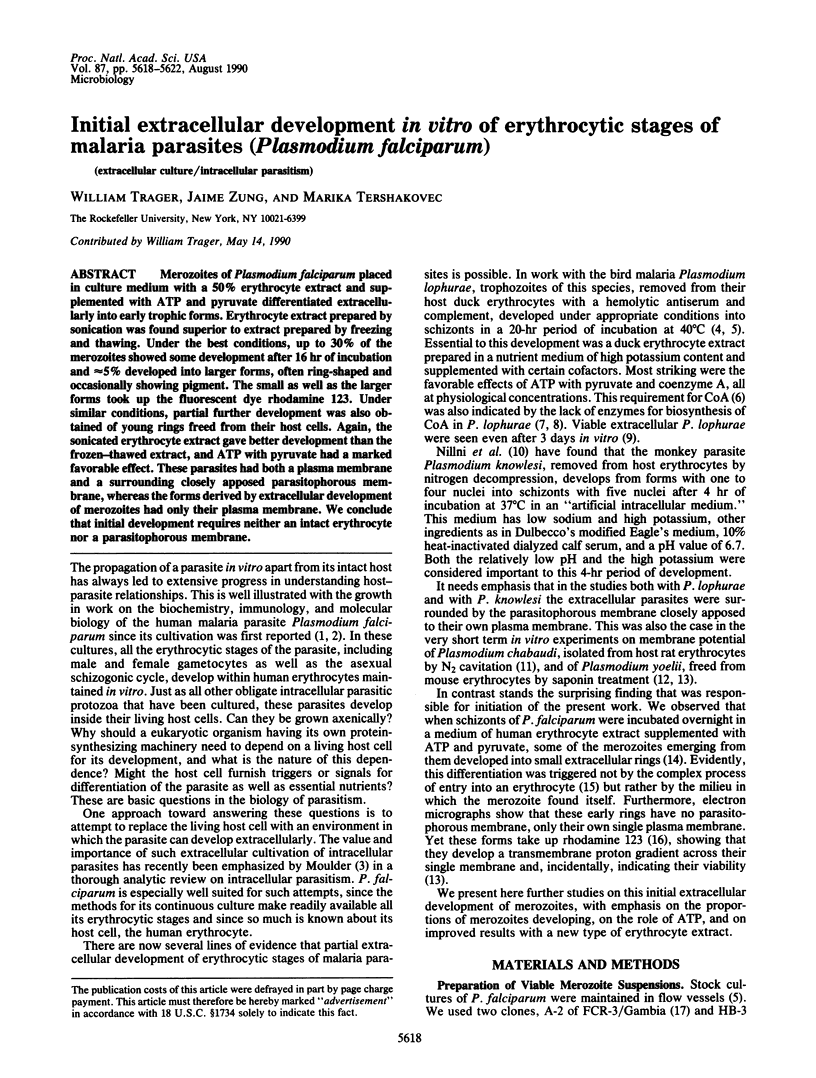
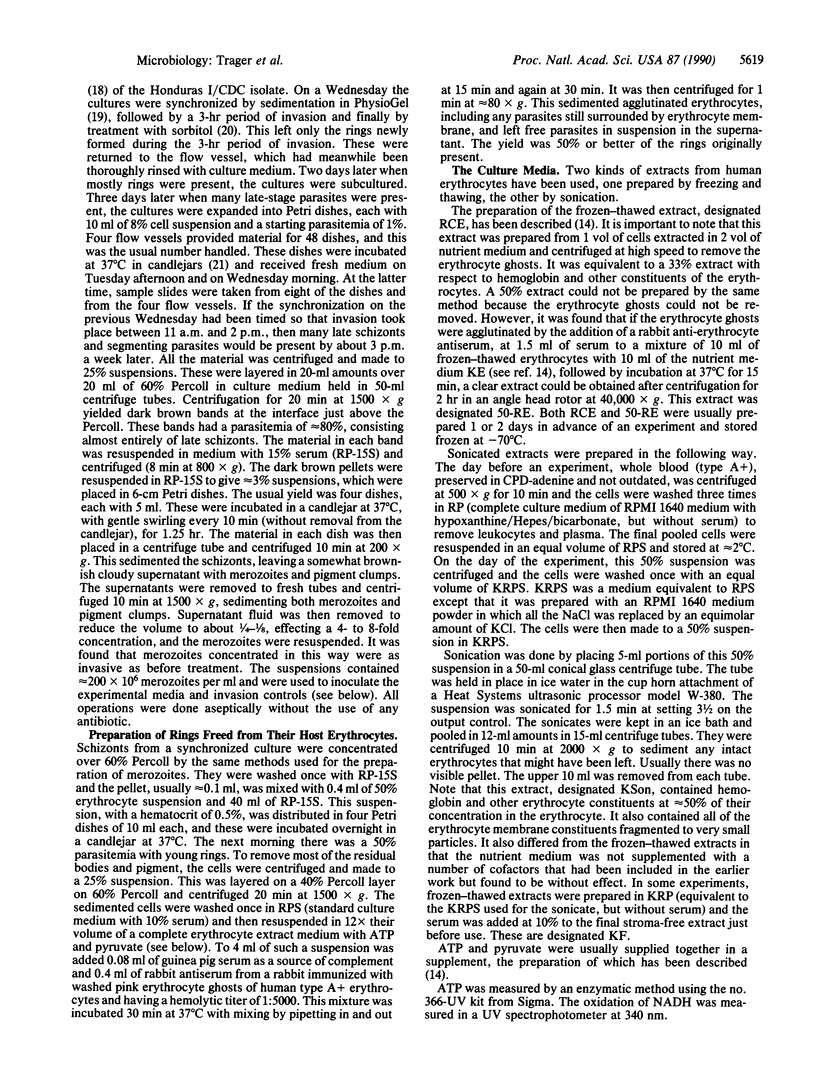
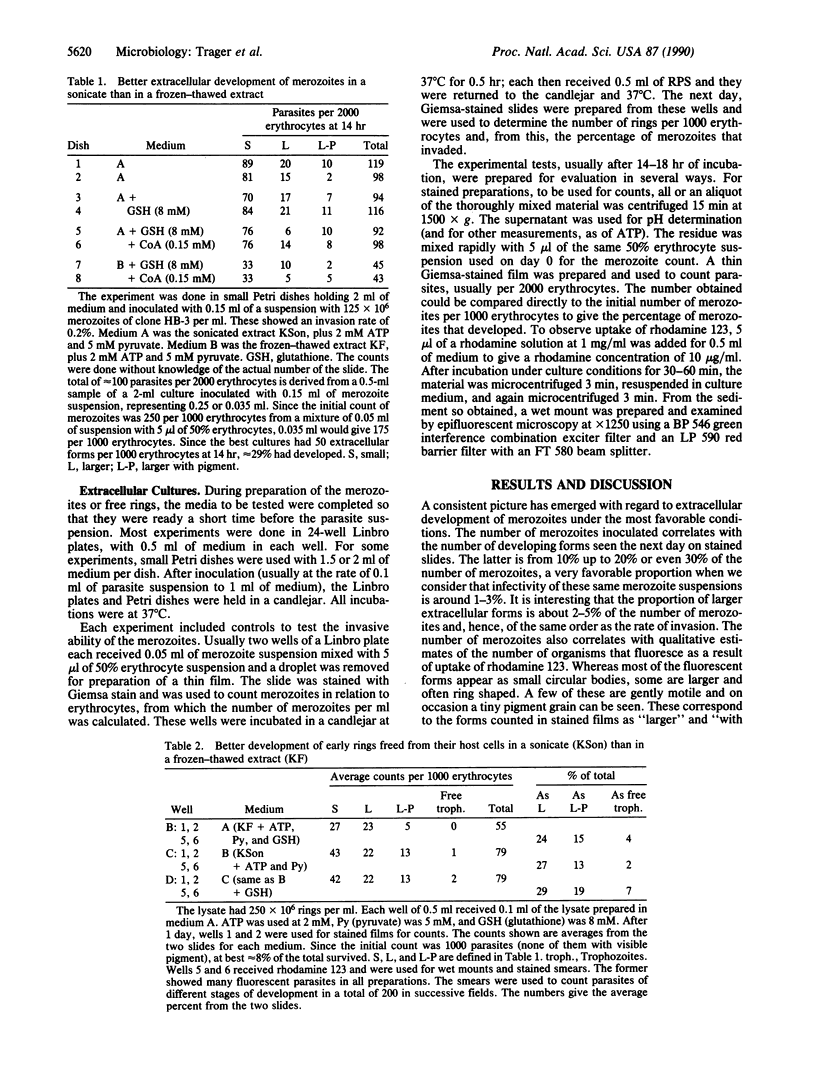
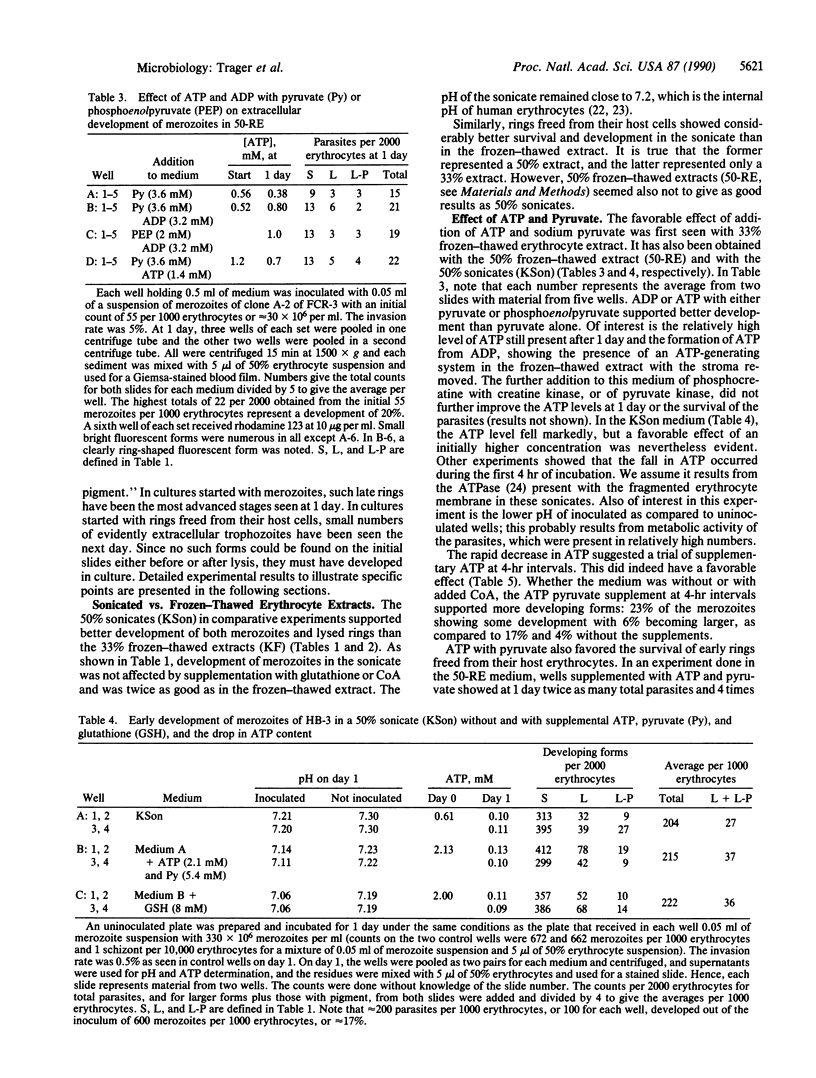
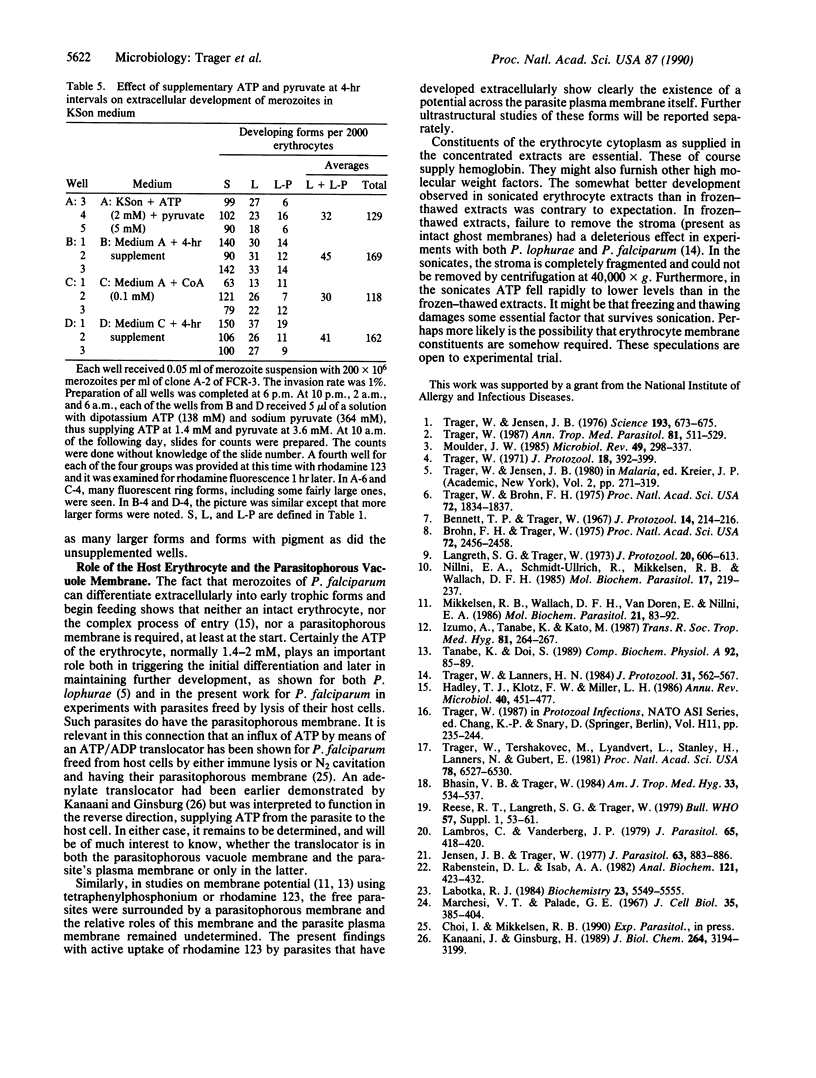
Selected References
These references are in PubMed. This may not be the complete list of references from this article.
- Bennett T. P., Trager W. Pantothenic acid metabolism during avian malaria infection: pantothenate kinase activity in duck erythrocytes and in Plasmodium lophurae. J Protozool. 1967 May;14(2):214–216. doi: 10.1111/j.1550-7408.1967.tb01985.x. [DOI] [PubMed] [Google Scholar]
- Bhasin V. K., Trager W. Gametocyte-forming and non-gametocyte-forming clones of Plasmodium falciparum. Am J Trop Med Hyg. 1984 Jul;33(4):534–537. doi: 10.4269/ajtmh.1984.33.534. [DOI] [PubMed] [Google Scholar]
- Brohn F. H., Trager W. Coenzyme A requirement of malaria parasites: enzymes of coenzyme A biosynthesis in normal duck erythrocytes and erythrocytes infected with Plasmodium lophurae. Proc Natl Acad Sci U S A. 1975 Jun;72(6):2456–2458. doi: 10.1073/pnas.72.6.2456. [DOI] [PMC free article] [PubMed] [Google Scholar]
- Hadley T. J. Invasion of erythrocytes by malaria parasites: a cellular and molecular overview. Annu Rev Microbiol. 1986;40:451–477. doi: 10.1146/annurev.mi.40.100186.002315. [DOI] [PubMed] [Google Scholar]
- Izumo A., Tanabe K., Kato M. A method for monitoring the viability of malaria parasites (Plasmodium yoelii) freed from the host erythrocytes. Trans R Soc Trop Med Hyg. 1987;81(2):264–267. doi: 10.1016/0035-9203(87)90235-5. [DOI] [PubMed] [Google Scholar]
- Jensen J. B., Trager W. Plasmodium falciparum in culture: use of outdated erthrocytes and description of the candle jar method. J Parasitol. 1977 Oct;63(5):883–886. [PubMed] [Google Scholar]
- Kanaani J., Ginsburg H. Metabolic interconnection between the human malarial parasite Plasmodium falciparum and its host erythrocyte. Regulation of ATP levels by means of an adenylate translocator and adenylate kinase. J Biol Chem. 1989 Feb 25;264(6):3194–3199. [PubMed] [Google Scholar]
- Labotka R. J. Measurement of intracellular pH and deoxyhemoglobin concentration in deoxygenated erythrocytes by phosphorus-31 nuclear magnetic resonance. Biochemistry. 1984 Nov 6;23(23):5549–5555. doi: 10.1021/bi00318a026. [DOI] [PubMed] [Google Scholar]
- Lambros C., Vanderberg J. P. Synchronization of Plasmodium falciparum erythrocytic stages in culture. J Parasitol. 1979 Jun;65(3):418–420. [PubMed] [Google Scholar]
- Langreth S. G., Trager W. Fine structure of the malaria parasite Plasmodium lophurae developing extracellularly in vitro. J Protozool. 1973 Nov;20(5):606–613. doi: 10.1111/j.1550-7408.1973.tb03584.x. [DOI] [PubMed] [Google Scholar]
- Marchesi V. T., Palade G. E. The localization of Mg-Na-K-activated adenosine triphosphatase on red cell ghost membranes. J Cell Biol. 1967 Nov;35(2):385–404. doi: 10.1083/jcb.35.2.385. [DOI] [PMC free article] [PubMed] [Google Scholar]
- Mikkelsen R. B., Wallach D. F., Van Doren E., Nillni E. A. Membrane potential of erythrocytic stages of Plasmodium chabaudi free of the host cell membrane. Mol Biochem Parasitol. 1986 Oct;21(1):83–92. doi: 10.1016/0166-6851(86)90082-4. [DOI] [PubMed] [Google Scholar]
- Moulder J. W. Comparative biology of intracellular parasitism. Microbiol Rev. 1985 Sep;49(3):298–337. doi: 10.1128/mr.49.3.298-337.1985. [DOI] [PMC free article] [PubMed] [Google Scholar]
- Nillni E. A., Schmidt-Ullrich R., Mikkelsen R. B., Wallach D. F. Extracellular development of Plasmodium knowlesi erythrocytic stages in an artificial intracellular medium. Mol Biochem Parasitol. 1985 Nov;17(2):219–237. doi: 10.1016/0166-6851(85)90020-9. [DOI] [PubMed] [Google Scholar]
- Rabenstein D. L., Isab A. A. Determination of the intracellular pH of intact erythrocytes by 1H NMR spectroscopy. Anal Biochem. 1982 Apr;121(2):423–432. doi: 10.1016/0003-2697(82)90502-4. [DOI] [PubMed] [Google Scholar]
- Reese R. T., Langreth S. G., Trager W. Isolation of stages of the human parasite Plasmodium falciparum from culture and from animal blood. Bull World Health Organ. 1979;57 (Suppl 1):53–61. [PMC free article] [PubMed] [Google Scholar]
- Tanabe K., Doi S. Rapid clearance of Plasmodium yoelii-infected erythrocytes after exposure to the ionophore A23187. Comp Biochem Physiol A Comp Physiol. 1989;92(1):85–89. doi: 10.1016/0300-9629(89)90746-9. [DOI] [PubMed] [Google Scholar]
- Trager W., Brohn F. H. Coezyme A requirement of malaria parasites: effects of coenzyme A precursors on extracellular development in vitro of Plasmodium lophurae. Proc Natl Acad Sci U S A. 1975 May;72(5):1834–1837. doi: 10.1073/pnas.72.5.1834. [DOI] [PMC free article] [PubMed] [Google Scholar]
- Trager W., Jensen J. B. Human malaria parasites in continuous culture. Science. 1976 Aug 20;193(4254):673–675. doi: 10.1126/science.781840. [DOI] [PubMed] [Google Scholar]
- Trager W., Lanners H. N. Initial extracellular development in vitro of merozoites of Plasmodium falciparum. J Protozool. 1984 Nov;31(4):562–567. doi: 10.1111/j.1550-7408.1984.tb05503.x. [DOI] [PubMed] [Google Scholar]
- Trager W. Malaria parasites (Plasmodium lophurae) developing extracellularly in vitro: incorporation of labeled precursors. J Protozool. 1971 Aug;18(3):392–399. doi: 10.1111/j.1550-7408.1971.tb03341.x. [DOI] [PubMed] [Google Scholar]
- Trager W., Tershakovec M., Lyandvert L., Stanley H., Lanners N., Gubert E. Clones of the malaria parasite Plasmodium falciparum obtained by microscopic selection: their characterization with regard to knobs, chloroquine sensitivity, and formation of gametocytes. Proc Natl Acad Sci U S A. 1981 Oct;78(10):6527–6530. doi: 10.1073/pnas.78.10.6527. [DOI] [PMC free article] [PubMed] [Google Scholar]
- Trager W. The cultivation of Plasmodium falciparum: applications in basic and applied research on malaria. Ann Trop Med Parasitol. 1987 Oct;81(5):511–529. doi: 10.1080/00034983.1987.11812153. [DOI] [PubMed] [Google Scholar]


